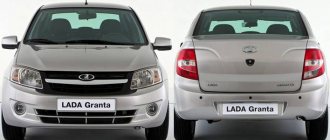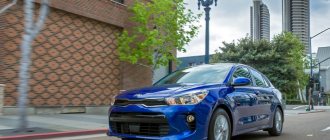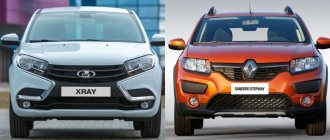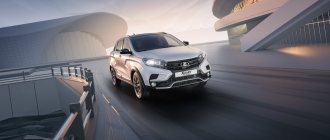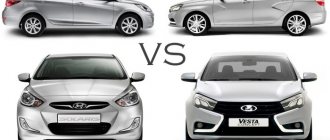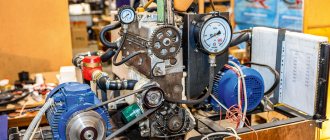The difference in price for these cars in the maximum configuration is about 160,000 rubles. We decided to find out whether the new Hyundai Solaris is as much better than the Lada Vesta as it is more expensive than it.
Oleg Kalaushin
Hyundai Solaris. Price: 899,900 rub. On sale: since 2017
Lada Vesta. Price: 735,900 rub. On sale: since 2015
One of my colleagues once expressed the idea that when purchasing a particular product, he first of all looks at the product itself and only then pays attention to the price. I don’t know how he does it, we seem to work in the same organization, but before I buy anything, I first ask the price, and only then, realizing whether I can afford this purchase or not, I begin to thoroughly study the product itself. I think this is what most people do, especially when it comes to purchasing a car. Otherwise, the roads would be full of premium cars driven by drivers with one kidney. Fortunately, the level of income of the population is still such that in order to purchase a car of the so-called budget level, you do not need to go to the table of transplantologists. As a last resort, you can turn to friends for the missing few tens of thousands, and a credit institution for a couple of hundred. However, as you know, if you want to lose a friend, take a loan from him, but if you want to significantly overpay for a car, go to the bank for a loan. As a result, most Russians rely only on themselves, and this is where the question of choice arises. And if you say that 160,000 rubles is not a sum worth racking your brains over, I will only envy you. Most likely, this reading will not be interesting to you, and you can safely turn the pages of our publication to the beginning, where we talk about cars worth several million. For those who are still concerned about the problem of prudent use of their hard-earned money, let’s continue.
Today, the new Hyundai Solaris in the maximum configuration with a 123-horsepower engine and a 6-speed automatic costs almost 900,000 rubles. Meanwhile, its classmate Lada Vesta with a similar power unit of 122 hp. With. and a robotic 5-speed gearbox will cost almost 736,000 rubles. So is it worth trying to save this amount by taking a Lada Vesta, or should you give up your principles, borrow and purchase a new Hyundai Solaris? We'll figure out.
Whether you like the design of the Lada Vesta, or have fallen for the mature Hyundai Solaris, that’s not the question now. Dimensions are what interests us first. And they are almost identical in cars. Yes, in numbers the Lada Vesta outperforms its competitor, but visually it is almost imperceptible. But the fact that the Lada’s ground clearance is almost 2 centimeters higher is clearly visible, especially when the cars are parked on a level surface. However, looking ahead a little, we can say that 160 mm Solaris is enough to avoid scratching your belly or front bumper on a light country road. If these 1.8 cm of ground clearance are still critical for you, then Lada Vesta is still in the lead.
Both cars have the same trunk volume. For both the first and the second it is 480 liters. The openings are also approximately the same, but... The trunk of the Hyundai Solaris can be opened from the interior, with the key, with a button on the lid itself, and, in the end, in the maximum configuration it can do this itself. All you have to do is approach the car from behind, wait three seconds, and it will open on its own. Lada Vesta does not have such an option. There is also no button on the lid itself. As a result, you have to open the trunk either with the key or with a button from the passenger compartment. By the way, when studying car trunks, it was noticed that in the Lada Vesta this is done by springs, like in most cars of this class, while in the Hyundai Solaris torsion bars are responsible for this - like in the domestic “classics”. It's hard to say which is better. On the one hand, the springs steal some of the volume from the sides of the car, on the other hand, the torsion bars can be damaged by stuffing something bulky into the trunk. In general, both have their own advantages and disadvantages. By the way, in both the first and second cars there are spare tires in the niche for the spare wheel. And although it’s hard to call a full-fledged 15-inch wheel on a steel rim a re-roller, this is exactly the case, because the main wheels on cars are 16 inches and cast.
Before starting to study the interiors, I would like to note that Solaris in the maximum configuration has an option such as keyless access to the interior, while Vesta does not have it. On the one hand, of course, it’s very convenient when you can get into the car and then start it without taking the keys out of your pocket, but on the other... The editors know a lot of people whose car was stolen by criminals. So whether this option is useful or not is up to you to decide.
The interior of both cars looks quite modern; in Vesta it is diluted with original inserts, which makes it visually even richer than its opponent. But to be frank, Solaris still looks more expensive. Take, for example, the instrument panel. It looks simple, but everything is easy to read on it. The characters are clearly drawn and the white backlighting looks very modern. Vesta's instrument panel is frankly tricky; what's especially inconvenient is that it doesn't light up unless you turn on the dimensions. And, of course, the arrows themselves could be more careful. However, at one time we used Vesta for a long time and gradually got used to such an instrument panel. But compared to Solaris, it clearly loses.
The settings of the steering wheel and driver's seat are the same for Solaris and Vesta, so it is not difficult to get comfortable behind the wheel in both cars. Vesta can only complain about the uncomfortable center armrest. Firstly, it is very narrow, and secondly, at the very moment when you want to raise it a little more to make it comfortable, it falls down. In Solaris, the armrest is not adjustable, but since it is not attached to the back of the driver’s seat, like in Vesta, but is a box cover, both the driver and the front passenger can use it. Solaris also has a much better picture on the central display. With Hyundai it is clearly readable in any weather, even in bright sunshine, but with Lada you always want to increase the contrast, despite the fact that the settings are at the maximum. Yes, and the picture from the rear view camera on the Solaris is clearer, plus it has an active trajectory hint, while on the Lada Vesta it is static and does not react in any way to turning the steering wheel. However, Vesta has no problems with rear visibility, especially since its exterior mirrors are much larger than those of Solaris. It is especially noticeable that they are much more convenient when moving in heavy traffic.
The back row is not very comfortable, but still more comfortable in Vesta. There is enough space for both legs and head, even for a tall passenger; in the Solaris, the “long-length” is less comfortable. The head, which actually rests against the ceiling, is especially affected. But if you are of average height or shorter, there will be no problems with placement here. By the way, unlike Vesta, Solaris has heated rear seats in the maximum configuration. And the driver can also warm his hands on the steering wheel. Vesta does not have such options. But there is a glove box with a cooling function, and it itself is much larger than that of the Solaris.
Vesta has a larger trunk opening, but Solaris has more ways to open it
To sum up the assessment of the interiors, we can say that by and large they are the same, adjusted for the presence of certain options, and here, naturally, you choose what is more important. According to general perception, Solaris is still in the lead.
But not only the exterior and interior determine the attitude towards the car. Let's move on to comparing their driving characteristics.
As already mentioned, competitors have engines of similar power. However, its 123 hp. With. Solaris uses a 1.6-liter engine, and Vesta uses its 122 with a 1.8-liter engine. What's the difference, you ask? Yes, by and large, not special, but, as a rule, the more horses are removed from a smaller volume, the less service life the engine has. However, people who buy a car only for the time it is under warranty should not worry about this. Moreover, both Solaris and Vesta have a warranty of 3 years or 100 thousand.
If we compare the dynamic indicators on paper, then the Solaris gains a hundred faster and its maximum speed is higher, but the Vesta still felt more dynamic, especially if you change the gears yourself, and not leave it to a robot, which, even though its brains have been tweaked with new firmware , but it was not possible to achieve perfect work. In this regard, advice. If you want to drive calmly, then you can completely trust the electronics; with this driving style, the gears shift adequately, and the shocks are not so noticeable. But if you need to rush, then take control into your own hands, and then Vesta will delight you with both dynamics and controllability.
The last indicator, it must be said, is at a very decent level. Solaris also pleases with good handling, and the automatic transmission on it is quite nimble, but, strange as it may seem, it was not easy for it to keep up with Vesta, especially in the first seconds after the start, which once again proves that sometimes power is not so important, as maximum torque, and for Vesta it is higher and amounts to 170 Nm versus 150 Nm, which is also available at much lower speeds. All this allowed Vesta to be more agile in the first seconds after the start. By the way, cars roar about the same, so things are about the same with the sound insulation of the engine compartment and everything in general. But the suspension is still stiffer on the Solaris. This is especially noticeable on not very good roads. Vesta, like all Russians, is much more lenient about our road sloppiness.
What's the end result? Is it worth overpaying this 160 thousand and taking Solaris, or can you stay with Vesta? Let's start with the fact that it is not at all necessary to take Solaris in the maximum configuration if you do not have enough money. Believe me, you can choose from eleven possible configurations, especially since the price starts at 600,000 rubles. But Vesta is not as poorer as it initially seems when you see the difference in price. Let's not forget that it is still a product of the domestic automobile industry, and not a foreign car, albeit with a large percentage of localization. This allows Vesta to be cheaper. It's cheaper, not worse.
But the bin volumes of the cars are the same - 480 liters
HYUNDAI SOLARIS price 899,900 rub.
| Driving Dynamic characteristics and handling are no worse than those of competitors and correspond to the class of the car
Salon High-quality plastic, well-fitted parts, thoughtful ergonomics. But there is not as much space in the back as we would like
Comfort Sound insulation could be better for such and such money
Safety Four airbags, ESP, ABS
Price Corresponds to a car of a higher class
Average score 8 |
The instrument panel is initially perceived as simple, but over time you begin to understand that you couldn’t ask for anything better. Reads well, all the necessary information is displayed in the middle window upon request
The new radiator trim added solidity to the car. And in general, the new Solaris has noticeably matured
The second row is not as spacious as imagined. The lack of space is especially noticeable for those who are taller than average
Two 12 volt outlets are very relevant today
Appearance, dimensions
Sedans have quite compact and small typical urban dimensions, which are almost identical in them, with only minor differences. But the exterior design of each of them is recognizable and unique. After restyling, the Korean became not only more modern, but also acquired quite aggressive features. And his opponent looks very original and unusual. Such a car cannot be confused with almost anything else, except perhaps with some new models of this brand. It is worth noting that this material only considers the Vesta sedan. This car is also available in the form of a station wagon, both regular and all-terrain, and a sedan with increased ground clearance.
Both cars, with the exception of their cheapest versions equipped with conventional steel wheels, will be sold on high-quality and stylish castings of the original design. For Hyundai, stylish and modern LED optics are also available in some trim levels, which are not yet installed on domestic sedans.
From the front, the Korean car looks not only very stylish and modern, but also quite aggressive. This effect is achieved due to the special shape of its narrow headlights, as well as the large radiator grille, which is painted black and visually appears connected to the headlights. The front bumper is quite large and equipped with many decorative elements. The rival seems unique and unusual due to the X-shaped chrome inserts installed in the front bumper, which has sufficient volume and considerable dimensions. The headlights of this car are also relatively small and have a slightly unusual shape. The radiator grille is quite large and consists of horizontal stripes.
When looking at Solaris from the side, it may seem quite simple. Its body does not have significant volume or relief, despite the presence of small stampings on the doors and wings. In some cases, this sedan may have chrome-plated door handles. But in the minimal versions, the handles, like the side mirrors, remain black for him and his opponent. In other trim levels, these elements of the cars are painted in body color. The rival from the side is strongly distinguished by the presence of noticeable X-shaped stampings on the doors and fenders. This solution is very unusual and allows the car to be noticeable in traffic, as it is found only in this sedan and some other modern cars of the domestic brand. Both cars have fairly large side windows and mirrors, which guarantees excellent visibility.
The rear of the Korean sedan attracts attention with the original shape of the lights, which are also relatively large in size. Its rear bumper is quite voluminous and has many decorative elements. The opponent's taillights also have a very unusual shape and appear larger. The car is distinguished by the presence of large chrome letters with the brand name on the trunk lid.
LADA VESTA price 735,900 rub.
| Driving If it were not for the specific work of the robot, the dynamics of the car could have been higher. There are no complaints about handling
Salon Quite spacious in the front and quite comfortable in the back. The workmanship is also up to par, but the materials could be richer
Comfort This indicator is greatly affected by the operation of the robotic box: passengers suffer from its jolts no less than the driver
Safety Four airbags, ESP, ABS
Price Corresponds to the car class
Average score 8 |
Vesta's design is quite bold, but bodybuilders have already called the car their nightmare
There is something wrong with the design of the shield. At first it is received with a bang, but over time you realize that it could be better in terms of ease of reading
The interior looks no worse than that of its competitor, and the inserts even decorate
Legroom in the second row is not much, but still a little more
The presence of cruise control will greatly please those who love long journeys. Unfortunately, it is not available on Solaris.
The central monitor could be more contrasting and brighter
What about the interior of sedans?
Almost all reviews from motorists note a well-organized driver’s seat in both brands of cars:
- Comfortable, moderately hard chair.
- Adjustable steering wheel for tilt and reach.
- Well-organized ergonomic center console.
- Informative dashboard and convenient location of the gearshift knob.
For some reason, the basic versions of the Korean sedan do not have a front armrest; only the top-end Elegance has a central box between the seats, the lid of which can be pulled forward. If anyone else hopes for soft, elegant plastic, then it is in vain - this is for the higher classes. Nevertheless, in appearance, both interior options, although they do not shine with impeccable assembly and quality, still look quite decent for their niche.
Both cars were assembled with virtually no defects. And yet, in the interior of the VAZ car there are several details that deserve criticism. For example, the steering column retaining element is made in such a way that you almost have to pull it out with your fingernail. Those who have not yet decided on the answer to the question Vesta or Solaris and what is better in their interior should take into account one more thing. The front seats of the “Korean” do not have lumbar support and are only height adjustable.
Rear passengers in the Hyundai cabin will now have more space due to the increase in body dimensions, but a tall person’s head will still rest against the ceiling. The trunk volume is now the same for both sedans - 480 liters, but the lid of the car from Korea can be opened with an electric button above the number.
Specifications
HYUNDAI SOLARISLADA VESTADimensions, weightLength, mm44054410Width, mm17291764Height, mm14691497Wheelbase, mm26002635Ground clearance, mm160178Curb weight, kg12591380Total weight, kg16101670Trunk volume, l480480Fuel tank volume, l5055Dynamics, efficiencyMaximum speed, km/h192186Acceleration time 0–100 km/h, s11,212,1Fuel consumption, l/100 kmurban cycle8.99.3suburban cycle5.36.0mixed cycle6.67.2Technologyengine's typepetrol, 4-cylinder petrol, 4-cylinderWorking volume, cm315911774Power hp at min-1 123 at 6300122 at 5900Torque Nm at min-1150 at 4850170 at 3700Transmissionautomatic, 6-speed robotic, 5-speedDrive unitfrontfrontFront suspensionindependentindependentRear suspensionsemi-dependentsemi-dependentBrakes (front/rear)disc/disc disc/drumTire size195/55R16195/55R16Operating costs*Transport tax, rub.30753050TO-1/TO-2, r.5700 / 97005000 / 7000OSAGO r.98589858Casco, b.65 00060 000* Transport tax in Moscow. TO-1/TO-2 - according to the dealer. Casco and OSAGO - based on 1 male driver, single, age 30 years, driving experience 10 years.
Suspension and Damping
As for the suspension, both cars performed quite well in handling. Yes, adjusted for class. Yes, not without some flaws, but still. Solaris is a softer and more comfortable car, designed for a quiet ride. On the road it is stable and very predictable. Both models are equipped with MacPherson front independent suspension with hydraulic telescopic shock absorbers. The rear suspension is represented by a semi-independent beam. The front and rear brakes of the new Solaris are disc.
Both Solaris and Vesta are equipped with a switchable stabilization system (ESP). The function is very useful and works quite reliably on both models.
Final rating
Hyundai SolarisLada VestaDriving8 points8 pointsSalon9 points8 pointsComfort7 points7 pointsSafety9 points9 pointsPrice7 points8 pointsFINAL RANKING8 points8 pointsWhat troubles await Solaris buyers?
In terms of reliability, Solaris is more reliable. Over nine years of work, drivers have identified many “diseases” and found ways to cure them. This:
- increased engine oil consumption;
- weak fastening of the cooling radiator impeller;
- grinding the gearbox input shaft bearing;
- kicks the automatic transmission;
- leaking from the steering rack.
There are currently 6,392 first generation Solaris available on the secondary chassis. Before buying, pay attention not only to the technical condition of the car, but also to the history, so as not to run into a problematic copy. For example, this car is sold at a “tasty” price of 315 thousand rubles:
A check through avtocod.ru showed that the car has restrictions on registration, unpaid fines and calculation of repair work:
The car, as the list of operations calculated by insurance shows, was involved in an accident. The rear of the car was badly damaged; restoration took almost 260 thousand rubles.
It is better to refuse this option.
Our verdict
Hyundai Solaris and Lada Vesta can be considered to meet modern requirements for cars of this class. As for the significant difference in price, it is not due to the fact that the Lada Vesta is worse, but to the fact that the Hyundai Solaris is a foreign car, although it is produced here.
Cars for test drive were provided by car dealerships: Hyundai Solaris - Rolf Lakhta, Lada Vesta - Lada Center Ozerki.
The editors recommend:
Quiz!
Blackvue DVR for knowledge of traffic rules Alternative to a scraper: how to clean car windows without scratching them
Better than Kruzak: Toyota presented a huge frame SUV
3 million is not a luxury: transport tax in Russia will be calculated in a new way
Which cars do dealers make the biggest markups on: list
Discussion Cancel
1 comment
- Arkady Alexandrovich:
12/20/2021 at 21:53
A foreign car, even if made of our own, is still exactly better than a VAZ.
Answer
Summary
This article did not say a single word about the reliability of the car produced in Tolyatti. Because no comparisons, reasons and arguments are needed by a person who 10-20 years ago drove domestic cars and swore never to buy them again. But if you don’t have such experience, then the Lada Vesta 2019 looks very attractive from a financial point of view. The advantage of 150 thousand rubles and above in all trim levels makes it the sales leader in Russia. It is also worth noting the possibility of purchasing this model in a station wagon and a CNG modification, which allows the use of two types of fuel: gasoline and methane.
But if you need a sedan with better dynamics and lower fuel consumption, and you prefer an automatic transmission to a robotic transmission, or, looking at the top trim levels, you want options that your competitor does not have, then the choice in favor of the Hyundai Solaris 2022 becomes obvious. But it also becomes obvious that in 2022 the Lada Vesta will continue to be in greater demand than the Hyundai Solaris. This is confirmed by the results of the first quarter of this year compared to the same period in 2022. Lada Vesta is increasing its lead over its competitor, thanks to sales growth of 15%, while Hyundai Solaris shows slight negative dynamics (sales of new cars fell by 2%).
See also:
Which is better: Hyundai Solaris 2022 or Kia Rio 2022 - comparison of models Which is better: Hyundai Solaris 2022 or Skoda Rapid 2022 - comparison of models
Which is better: Lada Vesta 2022 or Kia Rio 2022 - comparison of models
results
It is very difficult to determine exactly who won in this review - both products performed more than worthy. Vesta’s convenience, dimensions, and design are definitely better, but Solaris has an advantage in speed characteristics. The fight really turned out to be intense, but Vesta competed on an equal footing – the product can rightfully be called outstanding without any discounts. Just 2 years ago, it never occurred to anyone that a car could appear in our country that would be able to challenge the famous models of the foreign automotive industry.
